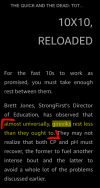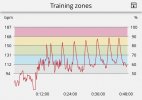Adachi
Level 7 Valued Member
Kettlebell - Geoff Neupert asks for beta testers for THE GiANT X and KETTLEBELL MAXIMORUM
Bottom line, I think it’s a rest issue. I know you’re assuming you’re getting sufficient rest, but maybe you’re not resting long enough. /\ THIS. Unfortunately, many, if not most guys STILL "race" their sets - try to get as many sets as possible, come hell or high water. I routinely get...
www.strongfirst.com
in the above post, @Geoff Neupert commends those participating in his programs for resting more and opines about resting more than you otherwise might in order to follow AutoRegulation.

I understand that autoregulation is great. it's a principle that you can take from one domain to another. but one of the reasons I'm so stuck on using a timer for my efforts is because, for my strength-centric goals, it seems to be so much easier to overdo my efforts than to underdo them. So, when I use repeat times or intervals, like the 30s, 60s, or 90s; I don't mean to discount Auto Regulation, but maybe confess that I'm not so good at it. there were many occasions working up from 16kg to 32kg in S&S 2.0 where I experienced a cramp in my glute or ran into another stop sign, and had to cut the day's work short. because my tendency to gauge recovery is a little off.
the reason I use these timed intervals is that I'm building in some rounding up on my rest periods. I'm overestimating my recovery times, and even as the necessary recovery times decrease as I continue a punch-the-clock training style, I find that I get breath recovery sometimes only halfway through the rest period. But, I have found that this seems to be an ingredient in my ability to better match my goals for sets reps and volume, with my ability to recover. because apparently my eyes are bigger than my stomach, and I seem to have a tendency to bite off more than I can chew. So, I remember these days to take a full period of rest. My feelings do not matter.
How do you approach your work/rest ratios and timing issues?
what signs do you rely on for starting a new set?
Last edited:

